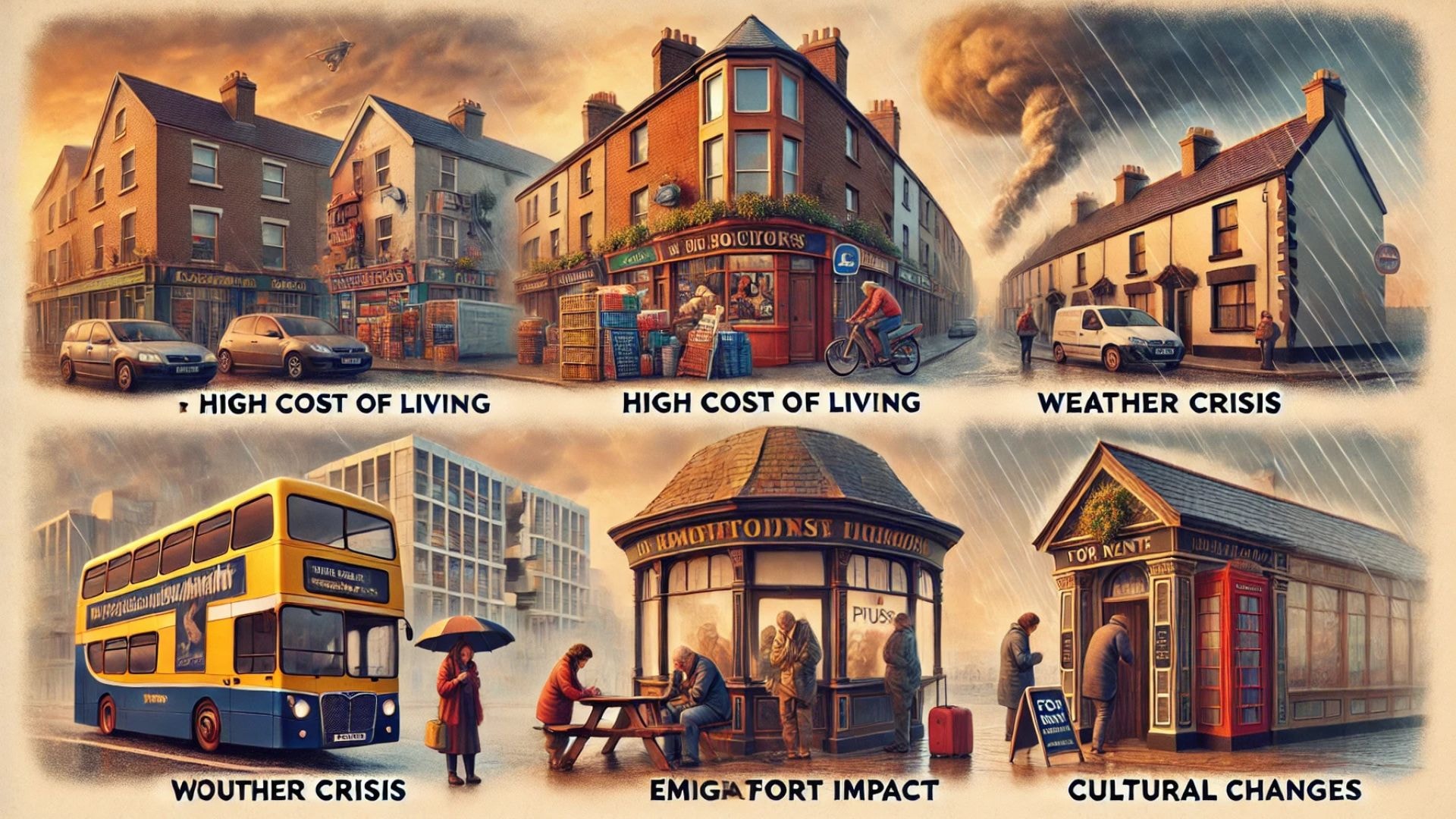
Disadvantages of Living in Ireland are:
-
High Cost of Living
-
Housing Market Issues
-
Unpredictable Weather Conditions
-
Limited Job Opportunities in Rural Areas
-
High Income Tax Rates
-
Challenges with Public Infrastructure
In addition to these disadvantages, it is important to consider the impact they have on daily life. The high cost of living, combined with housing market issues, can make it difficult for people to find affordable, quality accommodation, especially in urban areas. Unpredictable weather conditions can also disrupt plans and affect outdoor activities, while limited job opportunities in rural regions often force individuals to move to cities for work, adding to urban congestion.
High income tax rates may reduce disposable income, impacting overall financial well-being, and challenges with public infrastructure, such as unreliable transport systems, can lead to daily inconveniences and longer commute times.
1. High Cost of Living in Ireland

The top disadvantages of living in Ireland include the high cost of living. As an island nation, Ireland faces inherent challenges that contribute to higher prices for goods and services. This situation is exacerbated in urban areas like Dublin, where housing prices are particularly steep. The combination of high rent, expensive utilities, and elevated costs for everyday items can make daily life financially strenuous for both locals and expatriates.
-
Housing Prices: In major cities like Dublin, Cork, and Galway, rent and property prices are among the highest in Europe. This makes acquiring property or finding affordable rental options a significant challenge for many residents and newcomers.
-
Daily Expenses: The cost of groceries, dining out, and general shopping is noticeably higher in Ireland compared to the European average. Regular daily expenses can add up quickly, diminishing household budgets.
-
Utility Bills: Irish residents deal with high utility costs, which include electricity, gas, and water. These expenses are compounded by the country's climate, often necessitating continuous heating during long, damp winters.
-
Transportation Costs: Owning and maintaining a vehicle in Ireland is costly due to high fuel prices and insurance rates. Public transportation options, while available, also come with a high price tag, especially in urban areas.
Beyond the direct financial burdens, the high cost of living affects quality of life. It can limit disposable income, reduce savings, and restrict leisure activities. Even with a relatively high average income, many residents find it challenging to maintain a comfortable standard of living. This economic pressure can deter new residents and expatriates from settling in Ireland, impacting the country's cultural diversity and economic dynamism.
2. Unpredictable Weather Conditions

Unpredictable weather conditions are also one of the top disadvantages of living in Ireland, especially for those residing in the capital city or along the scenic west coast. Known for its quickly changing climate, Ireland's weather can shift from sunny to rainy within minutes, adding to the unique experience of living in European countries with similarly unpredictable climates. This constant unpredictability makes planning outdoor activities a challenge, often leaving residents frustrated. While students at University College Dublin and visitors exploring the famous pubs of Ireland may find the weather adds to the country's charm, these frequent shifts can impact day-to-day life, particularly for those accustomed to more stable conditions. The Irish government even considers weather patterns in its planning for national events, as the sudden weather shifts are a well-known part of life in Ireland.
In Ireland, it's not uncommon to experience all four seasons in a single day. From sudden rain showers to strong winds, Ireland's weather patterns keep people on their toes. Carrying an umbrella or rain jacket becomes a habit for many, as clear skies can quickly darken. The lack of long stretches of sunshine can be tough for individuals who enjoy outdoor sports, gardening, or simply spending time outside. Here’s how this affects daily life:
-
Constant rain and damp conditions: The roads become slippery, making driving and walking hazardous, which can extend commuting times. Public transportation may also face delays and disruptions.
-
Seasonal affective disorder (SAD): The limited sunshine contributes to higher rates of SAD among the population, affecting mental health with symptoms like depression and lethargy.
-
Impact on outdoor events: Frequent rain showers lead to the cancellation of many outdoor activities, including sports, festivals, and community events, reducing social interactions and recreational opportunities.
-
Challenges in daily chores: Tasks like laundry become more cumbersome as the persistent dampness delays drying, often necessitating the use of tumble dryers which increases household energy consumption.
-
Temperature fluctuations: The frequent and sudden changes in temperature lead to increased use of heating systems in homes, causing a rise in energy bills and impacting household budgets.
These detailed points illustrate the significant impact of Ireland's unpredictable weather on daily living. For many, the gloomy skies and frequent rainfall lead to a sense of cabin fever or stir feelings of restlessness, especially during the long, dark winters. While the lush, green landscapes are beautiful, they come at the price of Ireland’s constant rainfall, which affects the mood and energy levels of those who call it home, including Irish people in the city center or across Northern Ireland. Despite the weather, the charm of Irish culture, vibrant pubs Ireland, and a welcoming public healthcare system offer comforts that many find appealing. For residents considering Irish citizenship or holding an Irish passport, the connection to Ireland’s culture remains strong, even if they travel frequently to other European countries. The balance of natural beauty, affordable accommodation, and cultural richness makes life in Ireland unique.
Living with this unpredictability is a daily trade-off. Despite the island's charm and scenic beauty, the inconsistency of Irish weather remains one of the top challenges for residents. Adjusting to a lifestyle with rain as a regular companion can be tough, especially for newcomers hoping for more stable, sunnier days.
3. Housing Market Issues in Ireland
One of the other disadvantages of living in Ireland is the housing market issues that residents face. The housing crisis in Ireland continues to be a significant concern, characterized by high demand and insufficient supply. This imbalance has led to skyrocketing property prices and rental rates, making it challenging for many to afford suitable accommodation. Additionally, the concentration of job opportunities in urban centers like Dublin exacerbates the situation, leading to overpopulation and further strain on housing resources in these areas.
-
High Property Prices: The cost of purchasing a home in Ireland is prohibitively high, particularly in urban areas where employment is concentrated. This pricing trend pushes homeownership out of reach for many, especially first-time buyers and young professionals.
-
Elevated Rent Costs: Rental markets in cities are fiercely competitive, leading to inflated prices that consume a significant portion of residents' income. This issue is particularly acute in Dublin, Cork, and Galway, where rents can be comparable to much larger global cities.
-
Quality Concerns in Affordable Housing: Lower-cost housing often comes with issues such as inadequate heating, problems with mold, and outdated facilities, making them less desirable despite their affordability.
-
Urban-Rural Disparity: The lack of adequate and affordable housing options is not evenly distributed; urban areas face severe shortages while rural areas might have more availability but fewer job opportunities.
-
Long-term Stability Concerns: The volatile housing market impacts long-term residential stability, as people are forced to move frequently in search of affordable rent or in pursuit of property ownership opportunities.
These housing market issues contribute significantly to the drawbacks of living in Ireland. The rising costs associated with buying or renting a home impact the overall cost of living, making it difficult for new entrants to settle comfortably. Moreover, the lack of affordable housing options forces many into long commutes, as they seek more affordable living outside the cities, which in turn affects their quality of life and work-life balance. The government is implementing measures to address these problems, but progress is slow, and many residents continue to face these challenges.
4. Limited Job Opportunities in Rural Areas
A significant drawback of living in Ireland is the limited job opportunities in rural areas. This challenge stems from a concentration of economic activities in major cities like Dublin, Cork, and Galway, leaving rural regions lagging in employment options. Industries such as technology and finance thrive in urban centers, whereas rural areas mainly offer roles in agriculture and small-scale retail.
This disparity often forces residents to commute long distances for better job prospects or to relocate entirely, impacting the demographic and economic stability of rural communities.
-
Agricultural Dominance: The majority of employment in rural Ireland is tied to agriculture, offering limited roles with often seasonal or variable stability. This narrow focus restricts economic diversity and personal career growth.
-
Scarce Corporate Presence: Unlike urban areas, rural regions see a sparse presence of corporations and large businesses, which translates to fewer opportunities for professional employment in sectors like technology, marketing, or finance.
-
Educational Limitations: The lack of higher educational institutions in rural areas can lead to a shortage of skilled labor, further discouraging businesses from setting up operations in these regions.
-
Demographic Decline: As younger, educated professionals seek opportunities in larger cities, rural areas experience a brain drain, which affects local economies and community vitality.
The situation is compounded by the minimal presence of robust infrastructure to support significant commercial development, which is essential for job creation. Consequently, the cycle of limited job opportunities continues to affect the socioeconomic fabric of rural Ireland. Enhancing connectivity and investing in regional development could be pivotal in reversing this trend. Until then, the disparity in job opportunities remains a significant hindrance for those residing outside of Ireland’s city centers.
5. High Income Tax Rates
A notable downside of residing in Ireland is the high income tax rates. The country's tax system can significantly impact disposable income, particularly for high earners. This progressive tax system ensures that those with higher incomes contribute more, but it also means that personal financial growth can feel stifled. Many residents find that once they reach a certain income bracket, a large portion of their earnings goes to taxes, affecting their overall cost of living and tipping culture in Ireland including in taxis and restaurants.
-
Personal Income Tax: In Ireland, personal income tax rates start at 20% but quickly rise to 40% for earnings above approximately €35,300 for single individuals. This steep progression in tax rates can take a substantial portion of one's salary, making Ireland one of the higher-taxed countries in the European Union.
-
Universal Social Charge (USC): This is an additional tax on income that acts almost like a second income tax. It starts at 0.5% and can go up to 8% for higher earners. Everyone earning over €13,000 per year pays this charge, which does not contribute directly to pension entitlements, adding to the tax burden without direct personal benefits.
-
Pay Related Social Insurance (PRSI): Contributions to PRSI are mandatory for all workers. They fund various social welfare entitlements and benefits. While this is beneficial for accessing public services, it represents another deduction from gross income, further reducing take-home pay.
-
Employment and Investment Incentive (EII): While this scheme allows tax relief for investments in certain Irish businesses, it's another complexity in tax laws that can be both a blessing and a burden. Understanding and making use of such incentives often requires professional advice, adding to costs.
These high tax rates are often a shock to newcomers, especially those from countries with lower tax regimes. The high tax burden can discourage highly skilled professionals from relocating to Ireland, as they could net more income in other countries where the cost of living in Ireland compared to the US may be lower. Additionally, the complexity of the tax system can be daunting for those not familiar with it, requiring either significant personal effort to understand or the additional cost of hiring a tax professional.
However, it's worth noting that these taxes fund a range of public services. Ireland provides extensive social benefits, including healthcare, education, and social security, which are maintained through this taxation. This system aims to create a more equitable society, but it can be a significant adjustment for new residents and a point of contention for those who prioritize lower taxes over social benefits.
6. Challenges with Public Infrastructure
One of the significant disadvantages of living in Ireland involves challenges with public infrastructure. In many areas, residents face issues due to outdated and underfunded facilities. Roads, for instance, often show signs of neglect, with potholes and inadequate signage being common, especially in rural areas. Public transport systems also struggle to meet demand. The lack of sufficient buses and trains during peak hours leads to overcrowded conditions and delays, complicating daily commutes and access to essential services.
-
Water Infrastructure: Many communities deal with inconsistent water supply quality. Aging pipes and a lack of modern filtration systems contribute to this persistent issue.
-
Energy Grid Limitations: The national power grid faces challenges, particularly in adapting to new renewable energy sources. This transition strains existing infrastructure, causing occasional outages and reliability issues.
-
Internet Access: While urban centers enjoy high-speed internet, rural areas often encounter slow and unstable connections, impacting work and education.
Furthermore, investment in infrastructure has not kept pace with population growth, particularly in booming urban centers. The healthcare system is another critical area where infrastructure limitations are evident. Hospitals often experience overcrowding and long waiting times for treatments. This underfunding and lack of modernization not only impede daily life but also affect Ireland’s appeal as a place to live, especially for those accustomed to more robust infrastructure in other developed countries.
Pros and Cons of Living in Ireland vs USA
Evaluating the pros and cons of living in Ireland versus the USA reveals some distinct disadvantages of residing in Ireland. Costs, particularly for housing and consumer goods, tend to be higher in Ireland due to its isolated market and smaller economy. The weather in Ireland is consistently damp and overcast, lacking the varied climate experienced across the vast regions of the USA. Additionally, while Ireland offers rich cultural experiences and stunning landscapes, it may lack the same breadth of career opportunities, especially in technology and entertainment industries, that are abundant in the USA. This comparison sets the stage for a deeper exploration of the individual pros and cons in the sections that follow.
Pros of Living in Ireland
One of the pros of living in Ireland, compared to the USA, is the strong sense of safety and quality of life. Irish towns and villages often exhibit a close-knit community feel that is harder to find in many parts of the USA. This tight community network not only fosters friendships but also enhances personal security and support. Ireland consistently ranks as one of the safest countries in the world, with low crime rates and a high police presence, ensuring that residents feel secure in their daily lives. This sense of security is integral to the quality of life in Ireland, making it a significant advantage for those considering a move.
Scenic Beauty
Ireland's scenic beauty stands out as a significant pro when comparing living in Ireland to the USA. The country is renowned for its verdant landscapes, ranging from the rolling hills of the Emerald Isle to the majestic cliffs that line its coast. Places like the Cliffs of Moher, the wild landscapes of Connemara, and the serene lakes of Killarney offer breathtaking views and a deep connection with nature. These picturesque settings are not only a feast for the eyes but also promote a peaceful lifestyle and are perfect for countless outdoor activities. Ireland’s natural beauty significantly enhances the living experience, offering residents a unique blend of tranquility and adventure.
Quality of Life
The quality of life is a significant pro of living in Ireland compared to the USA. Ireland boasts a unique mix of modern amenities and captivating landscapes, creating a serene living environment. Work-life balance is highly prioritized here, featuring shorter working hours and generous vacation allowances, which greatly improve personal well-being. Healthcare in Ireland is both accessible and of high quality, contributing positively to residents' lives. Moreover, the strong sense of community offers a supportive and friendly atmosphere. This blend significantly enhances the overall quality of life for those residing in Ireland.
Cons of Living in Ireland
When comparing living in Ireland to the USA, two major disadvantages stand out: the weather and the job market. Ireland’s weather is notoriously unpredictable, with frequent rain, overcast skies, and a lack of distinct seasons, which can be challenging for those accustomed to the more varied climates found across the USA. This can affect outdoor plans and overall lifestyle, especially for those who enjoy sunshine and outdoor activities. Additionally, the job market in Ireland is more limited compared to the vast opportunities available in the USA. While cities like Dublin have thriving industries in tech and finance, the overall scale and diversity of employment options are smaller, making career advancement and sector-switching less flexible. This difference can be particularly striking for professionals used to the broad and competitive job market found in major American cities.
Weather
The weather in Ireland presents a significant challenge when compared to the climate in the USA. In Ireland, residents face frequent rainfall that permeates much of the year, leading to a predominance of overcast skies. The Irish climate is notably mild but often damp, contributing to a chilly feeling that persists through many months. This constant moisture can affect living conditions, penetrating homes and making outdoor activities less enjoyable. Additionally, the limited amount of sunshine can be particularly difficult for those accustomed to the sunnier, more varied climates found in many parts of the United States.
Job Market
The job market presents a notable disadvantage for those considering living in Ireland compared to the USA. In Ireland, job opportunities are heavily concentrated in urban centers like Dublin, Cork, and Galway, limiting options for those preferring or needing to live in other regions. While sectors like tech and pharmaceuticals offer numerous opportunities, the market is less accommodating for careers in manufacturing, arts, or hospitality, which are more robust in the USA.
Moreover, the Irish job market often offers lower salaries compared to the U.S., particularly noticeable in specialist and senior roles. This difference can make Ireland less attractive for highly skilled professionals looking for competitive compensation. Additionally, the smaller size of the country means fewer corporate headquarters and multinational companies, which can limit upward mobility and career growth opportunities compared to the vast and varied U.S. job market.
Pros of Living in the USA
The United States offers significant economic opportunities compared to Ireland, making it an attractive place for residents seeking financial growth. With its vast and diverse economy, the U.S. hosts numerous multinational corporations and industry leaders, particularly in technology, finance, and pharmaceuticals. This variety creates a wealth of job opportunities, often with competitive salaries and substantial career advancement potential. Moreover, the U.S. is renowned for its entrepreneurial spirit and supportive infrastructure for startups, which draws innovators and business founders globally. This dynamic economic landscape facilitates higher standards of living and financial stability for many residents.
Climate Variety
When comparing the living conditions between the USA and Ireland, one significant advantage in the USA is its climate variety. The United States offers a wide spectrum of weather conditions, ranging from the arid deserts of Arizona to the tropical climates of Florida. This diversity allows residents to select a living environment that aligns perfectly with their climate preferences. In contrast, Ireland generally experiences a more uniform climate, often characterized by cool temperatures and frequent rainfall, which may not appeal to everyone. This flexibility in choosing a preferred weather setting is a distinct benefit of residing in the USA.
Cultural Diversity
Living in the USA offers a significant advantage over Ireland when it comes to cultural diversity. The United States is known for its melting pot of ethnicities, languages, and traditions, providing a richer tapestry of cultural experiences than found in the relatively homogeneous society of Ireland. This diversity enriches every aspect of life, from food and festivals to music and art, allowing for a vibrant and dynamic environment. It enhances social interactions and broadens personal and professional networks, presenting countless opportunities to engage with and learn from various cultural backgrounds. In contrast, Ireland’s more uniform cultural landscape may offer fewer such interactions.
Cons of Living in the USA
One significant downside of living in the USA compared to Ireland is the high cost of healthcare. In the USA, individuals often face hefty insurance premiums, deductibles, and substantial out-of-pocket expenses, which can lead to financial strain. Unlike Ireland, where the healthcare system is more subsidized and accessible, the U.S. model relies heavily on private health insurance, making it less affordable for many. This can result in medical debt, which is a major concern for many Americans. The economic impact of healthcare costs in the USA starkly contrasts with the more manageable expenses faced by those living in Ireland, marking a clear disadvantage for U.S. residents.
Social Security
The Social Security system in the USA presents several challenges. Funding issues threaten the long-term sustainability of benefits. Retirees face uncertainty regarding the adequacy of future payouts. Administrative complexities can delay benefit disbursement. Compared to Ireland, where social welfare programs are more robust, the U.S. system often falls short in providing comprehensive support to its elderly and disabled populations.
Urban Sprawl
Urban sprawl is a significant downside of living in the USA. Cities often expand far into the suburbs, creating extensive distances between homes, workplaces, and amenities. This expansion leads to increased reliance on cars, contributing to traffic congestion and pollution. The spread of urban areas also consumes natural landscapes, reducing green spaces and habitats for wildlife. Furthermore, the cost and time of commuting can detract from quality of life, as more time spent in transit means less time for family, recreation, or rest.
FAQs On Disadvantages of Living in Ireland
1. What are the main disadvantages of living in Ireland?
The main disadvantages include high living costs, unpredictable weather, and limited housing availability.
2. Why is the cost of living considered high in Ireland?
Living costs in Ireland are high due to expensive housing, utility bills, and transportation costs.
3. How does the weather affect daily life in Ireland?
The weather in Ireland often disrupts plans with frequent rain and overcast skies limiting outdoor activities.
4. Is it difficult to find housing in Ireland?
Yes, finding housing can be challenging due to a competitive market and high rental prices.
5. What are the traffic conditions like in Ireland?
Traffic congestion is common in urban areas, particularly in Dublin, leading to long commuting times.
6. Are there any cultural drawbacks to living in Ireland?
Some may find the social scene less diverse, and adapting to local customs and accents can be challenging for newcomers.
7. What are the healthcare challenges in Ireland?
Healthcare access is sometimes delayed by long waiting times for certain medical services and procedures.
